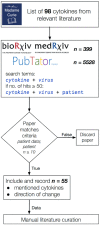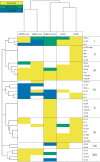SARS-CoV-2 Causes a Different Cytokine Response Compared to Other Cytokine Storm-Causing Respiratory Viruses in Severely Ill Patients
- PMID: 33732251
- PMCID: PMC7956943
- DOI: 10.3389/fimmu.2021.629193
SARS-CoV-2 Causes a Different Cytokine Response Compared to Other Cytokine Storm-Causing Respiratory Viruses in Severely Ill Patients
Abstract
Hyper-induction of pro-inflammatory cytokines, also known as a cytokine storm or cytokine release syndrome (CRS), is one of the key aspects of the currently ongoing SARS-CoV-2 pandemic. This process occurs when a large number of innate and adaptive immune cells activate and start producing pro-inflammatory cytokines, establishing an exacerbated feedback loop of inflammation. It is one of the factors contributing to the mortality observed with coronavirus 2019 (COVID-19) for a subgroup of patients. CRS is not unique to the SARS-CoV-2 infection; it was prevalent in most of the major human coronavirus and influenza A subtype outbreaks of the past two decades (H5N1, SARS-CoV, MERS-CoV, and H7N9). With a comprehensive literature search, we collected changing the cytokine levels from patients upon infection with the viral pathogens mentioned above. We analyzed published patient data to highlight the conserved and unique cytokine responses caused by these viruses. Our curation indicates that the cytokine response induced by SARS-CoV-2 is different compared to other CRS-causing respiratory viruses, as SARS-CoV-2 does not always induce specific cytokines like other coronaviruses or influenza do, such as IL-2, IL-10, IL-4, or IL-5. Comparing the collated cytokine responses caused by the analyzed viruses highlights a SARS-CoV-2-specific dysregulation of the type-I interferon (IFN) response and its downstream cytokine signatures. The map of responses gathered in this study could help specialists identify interventions that alleviate CRS in different diseases and evaluate whether they could be used in the COVID-19 cases.
Keywords: MERS- and SARS-CoV; SARS-CoV-2; cytokine response; influenza A; literature analysis; systematic review.
Copyright © 2021 Olbei, Hautefort, Modos, Treveil, Poletti, Gul, Shannon-Lowe and Korcsmaros.
Conflict of interest statement
The authors declare that the research was conducted in the absence of any commercial or financial relationships that could be construed as a potential conflict of interest.
Figures




Similar articles
-
Interindividual immunogenic variants: Susceptibility to coronavirus, respiratory syncytial virus and influenza virus.Rev Med Virol. 2021 Nov;31(6):e2234. doi: 10.1002/rmv.2234. Epub 2021 Mar 16. Rev Med Virol. 2021. PMID: 33724604 Free PMC article. Review.
-
Influenza infection, SARS, MERS and COVID-19: Cytokine storm - The common denominator and the lessons to be learned.Clin Immunol. 2021 Feb;223:108652. doi: 10.1016/j.clim.2020.108652. Epub 2020 Dec 14. Clin Immunol. 2021. PMID: 33333256 Free PMC article. Review.
-
Immunological map in COVID-19.J Microbiol Immunol Infect. 2021 Aug;54(4):547-556. doi: 10.1016/j.jmii.2021.04.006. Epub 2021 May 12. J Microbiol Immunol Infect. 2021. PMID: 34023234 Free PMC article. Review.
-
Diagnosis of SARS-CoV-2 infection in the setting of the cytokine release syndrome.Expert Rev Mol Diagn. 2020 Nov;20(11):1087-1097. doi: 10.1080/14737159.2020.1830760. Epub 2020 Oct 12. Expert Rev Mol Diagn. 2020. PMID: 32990479
-
A double edged-sword - The Complement System during SARS-CoV-2 infection.Life Sci. 2021 May 1;272:119245. doi: 10.1016/j.lfs.2021.119245. Epub 2021 Feb 17. Life Sci. 2021. PMID: 33609539 Free PMC article. Review.
Cited by
-
Multi-Condition QSAR Model for the Virtual Design of Chemicals with Dual Pan-Antiviral and Anti-Cytokine Storm Profiles.ACS Omega. 2022 Aug 29;7(36):32119-32130. doi: 10.1021/acsomega.2c03363. eCollection 2022 Sep 13. ACS Omega. 2022. PMID: 36120024 Free PMC article.
-
Significance of Immune Status of SARS-CoV-2 Infected Patients in Determining the Efficacy of Therapeutic Interventions.J Pers Med. 2022 Feb 25;12(3):349. doi: 10.3390/jpm12030349. J Pers Med. 2022. PMID: 35330349 Free PMC article. Review.
-
Elevated free interleukin-18 associated with severity and mortality in prospective cohort study of 206 hospitalised COVID-19 patients.Intensive Care Med Exp. 2023 Feb 24;11(1):9. doi: 10.1186/s40635-022-00488-x. Intensive Care Med Exp. 2023. PMID: 36823262 Free PMC article.
-
The superantigens SpeC and TSST-1 specifically activate TRBV12-3/12-4+ memory T cells.Commun Biol. 2023 Jan 20;6(1):78. doi: 10.1038/s42003-023-04420-1. Commun Biol. 2023. PMID: 36670205 Free PMC article.
-
Severity of SARS-CoV-2 infection is linked to double-negative (CD27- IgD-) B cell subset numbers.Inflamm Res. 2022 Jan;71(1):131-140. doi: 10.1007/s00011-021-01525-3. Epub 2021 Nov 30. Inflamm Res. 2022. PMID: 34850243 Free PMC article.
References
-
- Rahmati M, Moosavi MA. Cytokine-targeted therapy in severely ill COVID-19 patients: options and cautions. EJMO. (2020) 4:179–81. 10.14744/ejmo.2020.72142 - DOI
Publication types
MeSH terms
Substances
Grants and funding
LinkOut - more resources
Full Text Sources
Other Literature Sources
Medical
Miscellaneous

